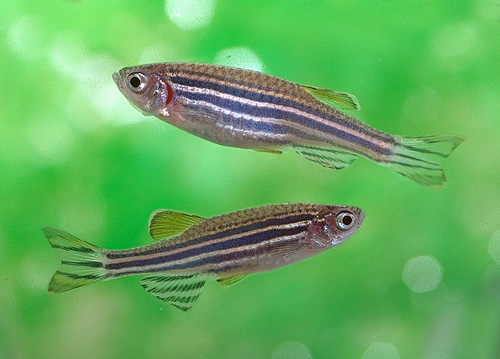
It grows fast, and is easy and cheap to look after in the research lab. You can see into its body – and even make its organs light up. About as long as two finger joints, it’s easy to manipulate for studying everything from genetics to microbial pathogens threatening human health.
Welcome to the zebrafish – the new “fruit fly” for the 21st century. Supplanting not just Drosophila but also the mouse in many research labs, this popular aquarium fish has become the model organism of choice for a range of scientific studies, including work by Guelph chemists, biologists and microbiologists.
One zebrafish champion is Prof. Terry Van Raay, Molecular and Cellular Biology (MCB). Like many other scientists of a certain age, he learned from the fruit fly. But he’s become a zebrafish convert, ever since he first used it to study molecular signaling pathways involved in development and disease.
Van Raay looks at specific genes and proteins that help guide embryo development. He’s also studying genetic mutations involved in regulating colon-related cancers.
Like more and more researchers, he’s increasingly netting results from Danio rerio. “A lot of people are moving out of the fruit fly into fish.”
Zebrafish won’t supplant mouse models for all research, he says. “Mammalian physiology and complex behaviours are hard to mimic in fish.”
But zebrafish offer a handier experimental model than conventional lab organisms. Fruit flies are easy to grow and keep, but as invertebrates, they’re too distant from humans to translate results readily. Mice specially bred with mutations to develop particular diseases have become commonplace in research labs, but they are expensive to keep and work with.

Zebrafish take only three months to mature and generate new offspring. Adults and embryos are transparent or at least translucent, making it easy to observe internal organs in live fish – even individual blood cells under light microscopes.
MCB Prof. Emma Allen-Vercoe’s lab has attracted attention for its Robogut, a benchtop system for simulating microbial activity in the gastrointestinal tract. Now she’s using zebrafish, too, for studies of how substances made by gut microbes might lead to the development of autism.
“The pathways of zebrafish brain development are extremely well understood,” says Allen-Vercoe.
She’s adding those microbial metabolites to water to see their effects on fish. She also hopes to use the creatures to test drugs and food additives.
Prof. Cezar Khursigara, MCB, uses zebrafish to study how biofilms enable infectious bacteria to resist drugs. “Biofilms are thought to be a major form of bacterial growth causing chronic infection, including the lungs of patients with cystic fibrosis,” says Khursigara.
Until now, he has relied on culturing pathogenic bacteria on plates. Now he plans to study immune responses to bacterial infection in the fish. He’s not alone.
“Every conference, every issue of infectious disease journals, the zebrafish keeps popping up,” he says. “Whether you’re looking at the microbiome or infection, the use of zebrafish in microbiology is skyrocketing.”
Last semester, John Dawson spent his research leave in Van Raay’s lab, learning to use zebrafish.
A biochemist in MCB, he studies heart muscle proteins involved in cardiovascular disease. He’s looked at molecular systems, but says, “I need to go beyond molecules to the whole organism.”
Last semester he learned about modern tools, including artificial DNA and gene editing tools, to examine specific genes and proteins. He hopes his work with zebrafish will ultimately lead to better drugs and therapies.
As an undergrad, Dawson had to choose between biochemistry or fish studies. He even spent summers working on government fish surveys in Muskoka before deciding on the biochemistry research lab.
“Lo and behold, it comes full circle. I’m studying fish.”